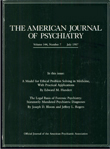Tramadol Dependence With No History of Substance Abuse
To the Editor: Tramadol is a nonscheduled analgesic drug thought to have minimal potential for abuse. The authors of a recent review of the misuse of tramadol (1) noted infrequent abuse by those without preexisting substance abuse. We report on a woman with no known history of substance abuse who developed tramadol dependence.
Ms. A, a 29-year-old woman, came to the hospital requesting detoxification from tramadol. Tramadol had been initially prescribed for the pain associated with carpal tunnel syndrome. Ms. A’s dose of one 50-mg tablet every 4-6 hours as need for pain had been slowly and surreptitiously increased. She had obtained the drug by going to several physicians and different hospitals with self-induced trauma (e.g., a bruised face) in an attempt to obtain increasing amounts of tramadol. After 3 years, she was taking about 30 50-mg tablets a day.
One day before admission, Ms. A had experienced two generalized seizures, and she had stopped taking tramadol. On admission she experienced a severe withdrawal syndrome with blurred vision, dizziness, diarrhea, headache, and insomnia. She reported no history of alcohol or drug abuse. Narcotics had been prescribed previously, but she had had no difficulty taking them. She reported low self-esteem and feelings of guilt, but otherwise she did not meet criteria for any other axis I or II disorders. A family history of alcoholism was noted. A physical examination revealed nothing of significance. Mild hypertension was observed. A CBC indicated slightly elevated white and red blood cell counts and normal differential counts. The results of a screening chemistry profile and urinalysis were within normal limits.
Ms. A was detoxified with tapering doses of tramadol and with celecoxib, metoprolol, and hydroxyzine. She improved gradually and was discharged after 6 days. Several months after discharge, she returned to the emergency room on two occasions with suspected self-inflicted lesions in an effort to obtain tramadol. The emergency room staff were informed of her addiction to tramadol to prevent further abuse. Ms. A did not return to the detoxification unit for follow-up care.
This is the case of a woman with no reported prior psychiatric or substance dependence history who became dependent on tramadol. Tramadol is a centrally acting analgesic that is neither opiate derived nor a nonsteroidal anti-inflammatory drug but binds to the mu opioid receptor. Tramadol is thought to have low potential for abuse. A postmarketing surveillance program to monitor tramadol abuse in the United States (1) indicated that the reported rate of abuse has been low, less than one case per 100,000 during the 2-year period before June 1998. However, unlike this case, the majority of cases of tramadol dependence have been found to occur among patients with a history of opioid dependence.
1. Cicero TJ, Adams EH, Geller A, Inciardi JA, Munoz A, Schnoll SH, Senay EC, Woody GE: A postmarketing surveillance program to monitor Ultram (tramadol hydrochloride) abuse in the USA. Drug Alcohol Depend 1999; 57:7–22Crossref, Medline, Google Scholar



